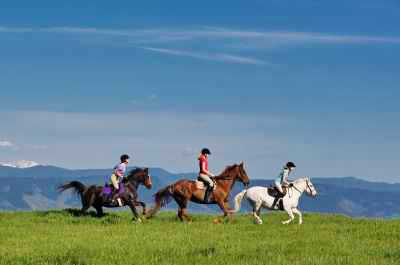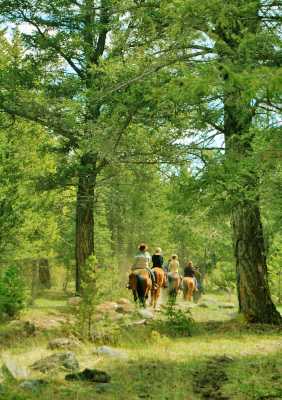|
By Jerry Tardif
Some people get into riding horses for competition and showing.
They get started by finding a barn specializing in their intended discipline that provides lessons.
Others just like the idea of exploring trails, forests, and mountains with a horse as companion.
Because trail riding is usually less structured, many of those interested in it presume they can just get on a horse and go — it's a little more complicated than that and not like driving a car or a motorcycle, because this vehicle has its own brain.

Cantering Along a Hilltop
The best way to start is still by taking riding lessons.
Lessons for new riders are almost always conducted in an enclosed space, such as in a paddock or arena.
In that space, your horse won't be inclined to run off and the possibilities of him being spooked are much less.
Plus, it's best to learn proper control and riding techniques from the start so you won't later have to unlearn bad habits.
Lessons for almost any discipline will help you.
That's because riding is all about balance and controlling the horse, and that's needed for all riding.
But you want to ride the trails and the confines of the ring can feel just so limiting — as a passionate trail rider myself, I do understand.
However, to do it safely, you still need to learn how to ride and control your horse first.
If you feel you want to experience trail riding sooner rather than later to help you decide whether or not you even want make the investment of time and money to take lessons, the best way is to find a barn that offers public trail rides.
To keep things safe (and limit their liability), they'll generally use calm, quiet horses and will provide a trail guide, maybe two.
The guides are usually competent riders that ride a lead mare or such that the other horses will follow.
Another guide will follow up in the rear and watch the riders from behind so he/she can intervene if a problem develops and assure that no one gets into trouble.

Walking Through the Forest
|
For new riders, most of the ride will be at the walk, but may also include a slow trot.
And truth be told, new riders would not enjoy a fast trot, canter, or gallop where they would find themselves bouncing around with a high risk of falling off, and worse, at speed.
Of course, if you have friends that ride and have an extra horse, that can also work, but you should be on a quiet, preferably older horse that's content to walk.
Older, experienced horses are also much less likely to spook because they "know the ropes" and are familiar with the sounds and sights of the trail.
And you?
You want to take in the beauty of nature around you and just enjoy the feeling of partnering with a beautiful and powerful animal beneath that's able to effortlessly carry you up hills and along the trails.
|
Trail riding is viewed by some as a simple riding form held in less esteem than the more regimented disciplines.
But in fact, it requires it's own expertise and skills that can rival the requirements of other disciplines — each discipline requires learning and practicing its required skills to be a competent and safe rider.
Shifting your weight left and right down the trail at a canter as you and your horse quickly weave your way between trees and brush dodging branches, scrambling up steep hills, and jumping over obstacles, such as fallen trees, requires good balance, skill, and control of and a mutual partnering with your horse — this is advanced riding and not the place for an untrained beginner!
And because of their herd mentality, horses want to move as a unit.
If one rider in a group breaks into a gallop, almost assuredly, the other horses will try to follow — and they know how to run.
For the beginner, that's a recipe for disaster because they can't control their horse and can't ride the faster gaits nor negotiate trail obstacles and other dangers.
Therefore, until they've learned how to ride, it's definitely not a good idea for beginners to go trail riding alone nor with experienced riders wanting to ride the faster gaits.
In addition, few other disciplines require the horse and rider to deal with so many distractions and potential for surprises.
There are more ways to spook a horse on the trail than in most other disciplines.
Surprises can come from hikers, hunters, deer, foxes, dogs, bees, blowing leaves, blowing horns, blowing trash and debris, a passing bicyclist, and many, many other sources.
I often see riders and horses of other disciplines out for a trail ride to give their horses a respite from the normal ring work.
Some of these horses and riders have big, frightened eyes because they and their horses are overwhelmed and anxious by all the activity going on around them.
That doesn't mean you should be afraid of trail riding, but it does mean that you need to learn how to deal with these challenges just as riders in other disciplines learn to deal with their challenges.
And it also means you want to have the right kind of horse with a calm temperament.
If you eventually want to be able to ride the trails alone, it's imperative to not only know how to ride and control a horse well, the horse also needs to know he can trust you.
Some of that occurs by being a competent rider while some is just by a horse getting to know and trust you over time.
A horse needs to feel that you'll keep him safe and not put him in a dangerous situation.
Each discipline requires techniques learned and improved over time with adequate practice — trail riding is no different, especially if, like some of us, you think a great time is cantering down a trail around trees in a thick forest.
For me, trail riding is the most exhilarating way to ride a horse.
It's an experience I'm so glad I've pursued and that has proven to be so very fulfilling.
And the relationship that has developed between my horse and me was a wonderful surprise I never anticipated.
But you want to work your way up to it, learn how to ride properly, and always wear proper safety equipment, such as a helmet and riding boots.
Trail riding is all about freedom, exploring nature's beauty, and partnering with a wonderful four-legged friend that will watch out for you while you watch out for him.
See you out on the trail!
Other helpful and related articles are:
Trail Riding Etiquette
Why I Wear a Riding Helmet
Riding Footwear
Winter Riding & Staying Warm
Safety Around Horses
Riding Balance
Besides being an avid trail rider, Jerry Tardif is a technology consultant and a horse and nature photographer in SE Connecticut — see his work at: www.jerrytardif.com.
He is also co-founder and President of QueryHorse.
Back to Article Index
|